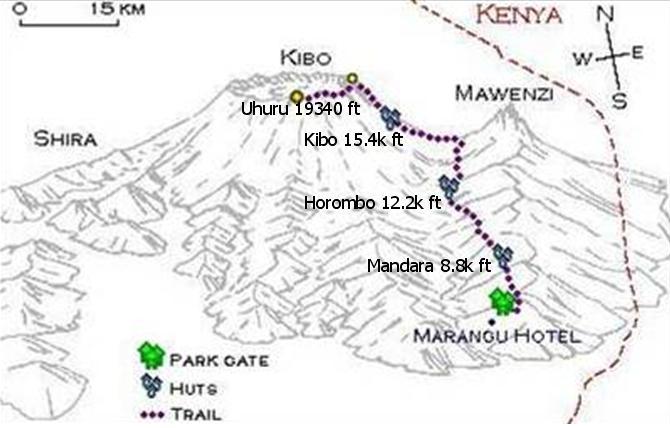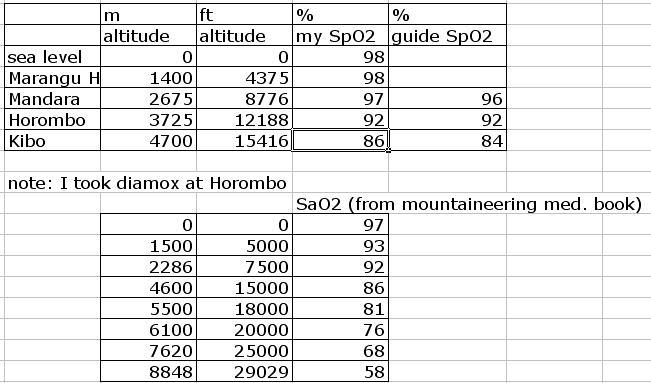
What was intended to be a small group of friends ascending the roof of Africa, ended up, unexpectedly, as a solo adventure. Maybe what I lost in social interactions, I gained by taking hundreds of pictures. I was also able to focus on the subject that interested me very much since my trip to Aconcagua. Specifically, it was the problem I had there with acclimatizing at the base camp [1] (~14.5k ft). When planning the trip to Kili, I decided to run a small experiment to see if the same decrease of oxygen saturation in my blood would happen. Of course, my plan was to avoid a decrease in O2 saturation at all cost. I decided to gain altitude on the first 3 legs of the trek very slowly, at a pace close to 1.5 mile per hour. Since I only carried my day pack, I was able to keep my heart rate very low. Additionally, I took Diamox at Horombo, and during the entire time on the mountain, I drank plenty of fluids (approx. ~4-5 l per day). These three legs were, sequentially, 1. from Park gates to Mandara huts; 2. from Mandara to Horombo; 3. Horombo to Kibo huts. On the third day, I reached Kibo huts in the early afternoon. After I ate dinner and slept for few hours, I started the final ascent after midnight, at 12:06am. My guide and I reached the peak at 5:26am. Since it was too early to take pictures of the glaciers, we stopped for longer break during our decent at Gilman's Point. Going back to the acclimatization process, it has to be stated that going from 6k ft. to ~19k ft. in 3.5 days doesn't give much room for acclimatizing. Because of this relative fast ascent, it's critical to observe how body reacts to increased altitude. One easy indicator, of course, is degree of headaches. Another easy-to-measure indicator is heart beat rate and SpO2 (Saturation of Hemoglobin with Oxygen as Measured by Pulse Oximetry) [2]. Below are results of SpO2 measurements I took of myself and my guide while going up and down the mountain, plus values cited by the following material [3].

Guide's and mines SpO2 measurements were done several hours after arriving at the destination camp using C1 Finger Pulse Oximeter [4].
The data shows that my oxygen saturation stayed on par with my guide's (who, by the way, is on that mountain once every two weeks average). Over the course of these 4 days, I observed that O2 saturation was more dependent on altitude, rather than time spent on the mountain. This is probably true in general, regardless of time spend on the mountain because the guide's measurement values showed the same characteristics. Another obvious observation is that saturation level, although necessary to be at least average for a given altitude, it is not a sufficient indication of acclimatization or performance level on the mountain. There are other factors that are not easy to measure without special equipment (i.e. VO2Max [5]). In a very crude & simplistic analogy, I think of SpO2 as a gasoline's octane rating, where the body's efficiency using that oxygen (possibly measured by VO2Max) represents performance of a car's engine.
There was one more interesting fact that I learned about the mountain during my stay at the Marangu Hotel, my outfitter. At the hotel, I got a chance to talk to one of the members of the tropical glacier research team from Innsbruck. He was staying at the same hotel with some respiratory problems, while the rest of his team was taking various physical measurements at the mountain's Kibo crater. From what I understood, the team is working on establishing a new theory of how Kili glaciers are forming and disappearing. If you are interested in learning more, follow the institute link [6].
1. http://www.climber.org/TripReports/2006/1472.html.
2. http://en.wikipedia.org/wiki/SpO2#Medical_science .
3. James A. Wilkerson, M.D. Medicine for Mountaineering & Other Wilderness Activities (5th ed.)
(the 5th edition of Medicine for Mountaineering & Other Wilderness Activities has some typos in the table sited above, which I corrected by interpolating.)
4. http://www.devonsuperstore.com/detail.aspx?ID=193 .
5. http://www.vo2maxtesting.net/whatis.cfm .
6. http://www.uibk.ac.at/geographie/index.html.de .
7. Some of my pictures from the trip: flickr.com/photos/35202851@N08/sets/72157613451306136 [link broken as of 2012]